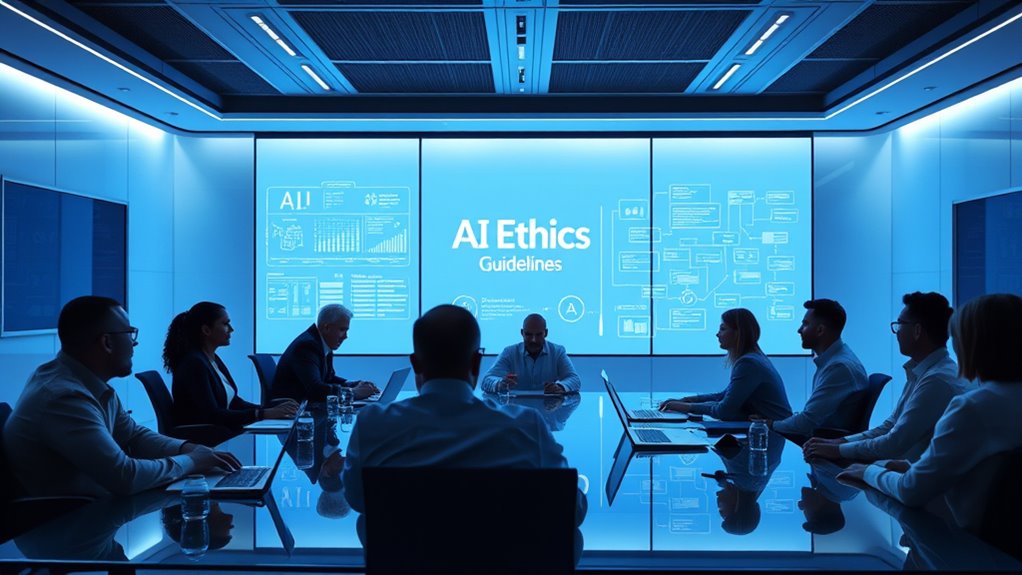AI ethics guidelines are well-intentioned but often fall short in practice. Many organizations struggle to fully embed ethical standards into daily operations due to gaps in implementation, cultural differences, and weak enforcement. Transparency remains a challenge, and biases often persist despite guidance. You’re likely to find that addressing these issues requires more than policies—ongoing effort, coordination, and adaptation are key. Keep exploring to discover how effective solutions are finally taking shape.
Key Takeaways
- Many organizations have ethical guidelines but struggle with effective implementation and translating principles into daily practices.
- Consumer trust remains low due to limited transparency and inconsistent adherence to ethical standards in AI deployment.
- Cross-border regulations and diverse cultural norms complicate enforcement and standardization of ethical AI practices.
- Biases and social impacts are often overlooked in guidelines, risking reinforcement of inequalities and social injustices.
- Practical challenges like resource constraints and governance gaps hinder the effective realization of AI ethics in real-world scenarios.
The Gap Between Ethical Principles and Organizational Adoption

Despite increasing awareness of AI ethics among executives, a significant gap persists between their stated principles and actual organizational practices. While 75% of leaders valued AI ethics in 2021, fewer than 20% strongly believed their practices fully reflect ethical standards. This disconnect means organizations often have policies on paper but struggle to embed ethics into daily operations. Consumers remain skeptical—only 40% trust companies to use AI responsibly, a figure unchanged since 2018. Many organizations face an “intention-action” gap, where commitment doesn’t translate into concrete behavior. Tools like self-assessment checklists exist, but adoption remains uneven. Complex governance structures, resource constraints, and lack of standardized frameworks hinder organizations from transforming ethical awareness into meaningful, operational practices. Additionally, the variability in projector technology and calibration challenges can serve as a metaphor for the inconsistencies in ethical implementation across organizations.
Consumer Expectations and the Demand for Transparency

Have you ever wondered how much transparency consumers expect from brands using AI? Over 80% believe AI-created content, like text, images, and videos, should be clearly labeled. More than half say transparency about AI use boosts trust in a brand. Nearly 90% want transparency around AI-generated visuals, with 98% agreeing authentic visuals are essential for trust. Yet, only 37% of Americans are comfortable with AI in marketing, showing skepticism. Consumers also see transparency as vital for ethical marketing, linking it to honesty and fairness. They expect brands to be accountable for accurate, unbiased content and to disclose AI use, especially in sensitive sectors. When brands are transparent, they build stronger trust; when they’re not, consumer perceptions suffer. Advanced Techniques can provide additional frameworks for implementing effective transparency practices.
Cultural and Regional Variations in AI Ethics Policies

Cultural and regional differences profoundly influence AI ethics policies, requiring frameworks to be adaptable and sensitive to local beliefs, values, and social practices. To succeed, you should consider:
- Reflecting local norms in AI applications, like healthcare advice tailored to dietary customs.
- Balancing global principles with regional cultural traits to prevent misalignment.
- Engaging communities to incorporate their perspectives, boosting trust and acceptance.
- Recognizing variations in privacy expectations and fairness standards to guarantee appropriate AI behavior.
- Ensuring cultural adaptability in AI development processes helps address the diverse societal norms and expectations across regions. Additionally, understanding the importance of Cultural Intelligence can facilitate more effective engagement with local stakeholders, ensuring AI policies are respectful and relevant.
Challenges in Enforcing Ethical Guidelines in Practice

Enforcing ethical guidelines in AI practice faces numerous challenges that can undermine their effectiveness. You often deal with a lack of transparency, making it hard to understand how AI reaches conclusions, which can erode trust. The complexity of AI systems complicates assigning responsibility when things go wrong, and insufficient human oversight can lead to unethical outcomes. AI’s probabilistic nature introduces uncertainty, making it difficult to guarantee ethical decisions. Operational complexity across diverse contexts hampers consistent enforcement. Additionally, the evolving legal landscape leaves gaps in regulation, especially across borders, where standards differ. Limited enforcement mechanisms and the technical limitations of AI—such as bias, explainability issues, and privacy concerns—further hinder effective compliance. These obstacles make it challenging to ensure AI aligns with ethical standards in real-world applications. Multiple agents involved in AI development and deployment further complicate accountability and responsibility attribution. Moreover, the technical limitations of AI such as bias, explainability issues, and privacy concerns, pose ongoing hurdles to ethical compliance.
Overlooked Ethical Concerns and Bias in Guidelines

Many AI ethics guidelines overlook how technology impacts society and fail to prioritize social consequences. You might notice that gender diversity gaps often go unaddressed, leaving biases unchecked. Without focusing on these issues, AI systems risk reinforcing inequalities and societal harm. Emerging frameworks across sectors emphasize fairness and social well-being, but practical implementation remains inconsistent. For example, neglecting the importance of social implications can undermine efforts to create equitable AI solutions.
Missing Social Impact Focus
Most AI ethics guidelines focus primarily on technical issues like bias, privacy, and legal compliance, often neglecting broader social impacts. This oversight means they rarely address how AI affects vulnerable communities or worsens social inequalities. You might find that: 1. They overlook concerns like socioeconomic disparity and workforce displacement. 2. Guidelines lack guidance on engaging the public or considering social contexts. 3. Long-term societal risks and systemic harms are often ignored. 4. Practical tools for evaluating AI’s social impact are scarce or absent. Additionally, many frameworks do not incorporate social impact assessment methods to systematically measure AI’s influence on society. As a result, these frameworks fall short in promoting responsible AI use that genuinely benefits society. Without a focus on social impact, AI deployment risks perpetuating injustices and deepening social divides, undermining the very ethical principles they aim to uphold. Understanding the importance of cultural context can help develop more comprehensive guidelines.
Gender Diversity Gaps
Have AI ethics guidelines sufficiently addressed gender diversity gaps and the biases that persist within these systems? The truth is, they often fall short. AI models learn from historical data filled with gender stereotypes, reinforcing biases like associating men with technical roles and women with caregiving. This results in biased outcomes in hiring, healthcare, loans, and legal decisions, limiting opportunities for marginalized genders. The underrepresentation of women in AI development deepens these issues, as teams lack diverse perspectives to identify and correct biases early. While some frameworks promote intersectional approaches and stakeholder collaboration, many guidelines overlook practical implementation. Without actively addressing data diversity and inclusion in development teams, gender biases continue to permeate AI systems, perpetuating inequality rather than resolving it. Additionally, expert advice – My dogs’ names emphasizes the importance of diverse input in fostering equitable AI systems.
The Role of Regulatory Frameworks and Global Cooperation

You need to understand how international regulatory alignment is essential for consistent AI governance across borders. Cross-border ethical standards help prevent regulatory gaps that could undermine safety and human rights. Strengthening global cooperation guarantees AI development benefits everyone while managing risks effectively. Additionally, adopting cultural and regional breakfast traditions as models can foster more inclusive and adaptable regulatory approaches.
International Regulatory Alignment
How can nations effectively coordinate their AI regulations amid diverse legal traditions and priorities? It’s a challenge, but progress exists. Here’s how:
- Adopt model frameworks like the EU AI Act, which uses risk-based categorization to guide compliance.
- Engage in international dialogues to share best practices, even if full harmonization remains elusive.
- Align regulatory goals by emphasizing common values like safety, transparency, and human oversight.
- Support cross-border cooperation through organizations and treaties that facilitate information exchange and joint enforcement.
- Facilitate the sharing of regulatory data to improve understanding of AI risks and enforcement effectiveness across borders. 75% of UK firms use some form of AI, up from 53% in 2022, with applications including credit risk, algorithmic trading, and capital management. Additionally, establishing common standards can help reduce regulatory fragmentation and promote trust among stakeholders.
While a unified global regulation seems unlikely now, these steps foster cooperation, reduce fragmentation, and help companies navigate varied legal landscapes more effectively.
Cross-Border Ethical Standards
Cross-border AI governance faces significant challenges because of differing cultural values and fragmented data protection laws. You’ll find that inconsistent regulations cause compliance conflicts—what’s legal in one region might violate another’s laws. Efforts to harmonize frameworks focus on fairness, bias reduction, and transparency, but progress varies globally. Universal ethical standards help promote fairness, human oversight, and accountability across jurisdictions, fostering trust in AI, especially in sensitive sectors like healthcare and law. Regulatory frameworks such as GDPR and HIPAA aim to unify data privacy and risk assessments, yet many laws remain in development, creating uncertainty. Interoperable standards for data privacy, transparency, and cybersecurity help streamline cross-border AI deployment, reducing friction. International cooperation through shared platforms and training encourages consistent governance, balancing innovation with societal values. Global coordination is essential to address these disparities and ensure effective AI governance worldwide. Additionally, fostering cultural sensitivity in policy development can enhance the effectiveness of international standards, respecting diverse societal norms while maintaining core ethical principles.
Future Directions for Effective Ethical AI Implementation

To guarantee ethical AI is effectively integrated into future systems, stakeholders must develop thorough and adaptable frameworks that address existing gaps and anticipate emerging challenges. You should focus on:
- Creating standardized, enforceable guidelines that align with societal values and balance transparency with technical complexity. Robust data governance and accountability mechanisms are essential to ensure ongoing compliance and responsible AI development.
- Promoting industry-wide adoption by embedding ethical principles into core operations, not treating them as optional.
- Fostering collaboration among governments, academia, and businesses to develop coherent, effective standards.
- Establishing robust data governance and accountability mechanisms to ensure ongoing compliance and responsible AI development.
Frequently Asked Questions
How Do Organizations Measure Success in Ethical AI Implementation?
You measure success in ethical AI by tracking key metrics like transparency, bias detection, and risk scores. You establish clear organizational roles, such as ethics committees and responsible officers, to oversee compliance. Using automated monitoring tools and regular audits helps you evaluate progress. You also focus on continuous improvement, updating standards, and ensuring ethics are integrated into project workflows, making sure your AI remains fair, accountable, and aligned with societal values.
What Role Do Cultural Differences Play in Shaping AI Ethics Policies?
Ever wonder how cultural differences influence AI ethics policies? You see, they shape what’s considered fair, transparent, or respectful in each society. You might realize that what works in one country could offend in another. So, you need to recognize these diverse values, adapt standards accordingly, and foster inclusive dialogue. Isn’t it essential to respect cultural nuances to create AI systems that truly serve everyone’s needs?
How Can Regulators Ensure Compliance With Ethical AI Standards Globally?
You can guarantee compliance with ethical AI standards globally by adopting clear, risk-based regulations like the EU AI Act and aligning them with international standards such as ISO/IEC 42001. Implement transparency, human oversight, and robust data governance. Leverage technology to automate compliance, stay adaptable to evolving laws, and foster international cooperation. This way, you ensure your AI systems meet diverse regulatory requirements while prioritizing ethics and safety worldwide.
Why Do Many Ethical Guidelines Lack Detailed Enforcement Mechanisms?
Imagine a blueprint for a building that shows the design but lacks instructions for construction. That’s why many ethical guidelines fall short—they outline ideals but skip concrete enforcement steps. You see principles without clear responsibilities, oversight, or penalties, making compliance voluntary. Without detailed mechanisms, accountability becomes vague, and organizations can ignore ethical breaches. This disconnect creates a gap between aspiration and action, leaving ethical standards more theoretical than practical.
What Strategies Can Address Overlooked Issues Like AI Militarization and Disinformation?
You can tackle issues like AI militarization and disinformation by pushing for stronger international agreements that limit autonomous weapons and promote transparency. Support developing multilateral frameworks for AI export controls and real-time disinformation detection tools. Advocate for rigorous audits and accountability for military AI systems, ensuring they follow ethical standards. Additionally, collaborate across government, tech, and academia to stay ahead of risks and update guidelines as technology advances.
Conclusion
Remember, actions speak louder than words. While ethical guidelines are a good start, their true value depends on your commitment to applying them consistently. Addressing cultural differences, enforcing standards, and staying transparent aren’t easy, but they’re essential for trustworthy AI. If you want your organization to lead ethically, don’t just talk about principles—make them a daily reality. After all, the proof of the pudding is in the eating.









